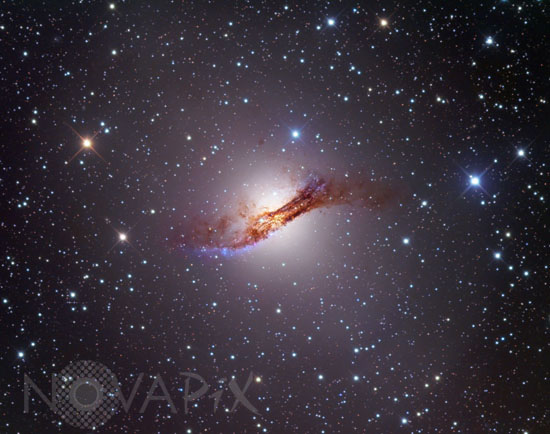Photo Agency - Astronomy - Space - Nature

The radio galaxy Centaurus A (NGC 5128)
auteur: R.Gendler/Novapix
référence: a-gax51-28019
Image Size 300 DPI: 26 * 20 cm
NGC 5128 is the nearest large elliptical galaxies to our sun at about 13 millions light years. It is also the nearest of the giant radio galaxies, possessing an active galactic nucleus (AGN) and optically one of the most luminous galaxies in the sky. In 1949, NGC 5128 was found to be a loud source of radio energy, in fact the loudest radio source in its region of the sky (second overall to Cygnus A) , earning it the designation Centarus A. As a radio galaxy it releases 1000 times the radio energy of the Milky Way in the form of large bi-directional radio lobes that extend some 800,000 light years into intergalactic space. The source of the radio emission is very compact, about 10 light days across and is believed to be a supermassive black hole in the galaxy's center with a total mass of 200 million to possibly one billion suns. As a radio galaxy, NGC 5128 belongs to the subgroup of galaxies called Active Galaxies, which include Quasars, Seyfert galaxies, Blazars and and Radio Galaxies. Active galaxies are distinguished by their prodigious energy output which cannot be explained by their stellar populations and must have another source. Active galaxies have in common an "Active Galactic Nucleus (AGN)" which is believed responsible for their prodigious energy output. Supermassive black holes are almost certainly the central engines of Active Galactic Nuclei, powering the enormous outflows of energy which characterize this subgroup of bright galaxies. Image taken with 14.5" RCOS telescope, 11 Hours of exposure.
Contact : Stéphane Aubin +33-(0)9-51-26-53-76
© Novapix - All rights reserved






